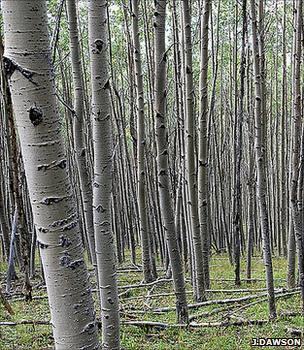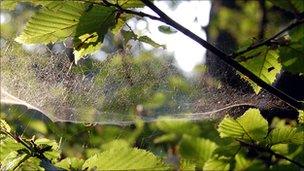Nursery effect study shows trees remember their roots
- Published

Tree species like the aspen propagate vegetatively, resulting in stands of genetically identical trees
Genetically identical forest trees raised in different environments react differently when exposed to drought conditions, a study has shown.
The authors have said it is the first scientific critique of the "nursery effect", in which trees develop certain profiles based on where they are grown.
The team took the same varieties of trees from different areas and measured how their responses to drought varied.
The findings appear in the Proceedings of the National Academy of Sciences, external.
"The nursery effect is something that had been noted in an anecdotal fashion by foresters and gardeners," explained co-author Malcolm Campbell from the University of Toronto.
The team found that it had not be reported or documented in any detail within scientific journals, yet it was a concept that was being widely used.
Professor Campbell explained how it could have an impact on commercial growers.
"Imagine you want to set up a new orchard, and you go to one nursery to get a sample," he told BBC News. "You put it in your orchard, and you decide that you like that variety of tree.
"So you decide to get more but you have to go to a different nursery to get more. You put those in your orchard and you find that - for whatever reason - those trees do not fare so well, even though they are genetically identical to the original tree."
He added that unlocking the secrets of the nursery effect would also help solve a scientific conundrum of how genetically identical long-lived organisms that propagate vegetatively, such as aspens via suckers growing from the root system, can be resistant to extreme weather, pests and pathogens.
He said it would be fair to assume that if one individual fell foul of the weather or a pest, then all the specimens would be considered vulnerable.
But that would suggest that vegetative propagation would have been neither a very good nor successful evolutionary strategy, yet it is a method of reproduction adopted by plants all over the world.
Professor Campbell asked: "So might there be something similar to a nursery effect that offers protection in the natural world?"
In order to test this, the team used clones of three widely grown varieties of poplar tree from a number of regions within Canada that had markedly different climates and environments:
DN34 (Populus deltoides x Populus nigra) - propagated since the early 1900s
Walker (P.deltoides var. occidentalis x (P.lauifolia x P.nigra)) - propagated since 1946
Okanese (Walker x (P.lauifolia x P.nigra)) - propagated since 1986
As Populus is a genus of trees that require sizeable volumes of water and are sensitive to changes in the water content within soil, the team felt subjecting half of the samples to drought conditions would trigger a stress response within them.
"As we were looking at genetically identical individuals, the hypothesis was that if you grew them under identical conditions, and you monitored them at a time when they would be responding physiologically in an equivalent fashion, then what was happening behind the scenes - the way in which the genes are functioning - should also be the same," Professor Campbell explained.
"We looked at the way genes functioned. We had the capacity to take a snap shot of how 45,000 genes in poplars were responding at any particular point in time.
"By comparing the snapshots between water and drought conditions, we could then understand how those genes responded."
'Stunning findings'
The team found that the samples of Okanese, the youngest variety, did behave in a manner that supported the hypothesis.

The researchers say their findings could led to harnessing the "nursery effect"
"Individuals of Okanese that we obtained from Alberta performed identically to those we examined from Saskatchewan," he revealed.
"They were sourced from the two locations, brought into the same garden and treated the same way - and responded in the same way.
However, Professor Campbell explained, samples of the two older varieties provided "stunning findings" because the specimens from Saskatchewan performed differently when compared with clones taken from other locations.
"As you looked at an older clone, the response was more divergent. Okanese had no difference in response, Walker was intermediate, and DN34 was the most divergent."
He said that the findings suggested that time played a key part in how plants responded to changes in their environment, adding that the findings matched the results of studies on human identical twins.
"Spanish research showed that very young twins (three-year-olds) showed no difference in the way their genes responded," he recalled.
"But as they looked at older and older twins such as 50-year-olds, they had divergent patterns of gene activity. If the individuals were brought up in different environments (for example being put up for adoption) then the patterns of divergence was even more marked."
Professor Campbell said that he envisaged carrying out many more years of research in this area, but said that the study's findings presented a "double-edged sword".
"On a cautionary note, it suggests that people need to watch where they get their trees and plants from," he said.
The precise location nursery trees are sourced from, he said, "could have a profound effect on how they would perform in later years".
"But there is a positive note as well, and it is one that I think will drive research," he added.
"You might be able to find the means in which to create conditions that will train the genome so then it will be better suited for whatever environmental conditions are further down the line."